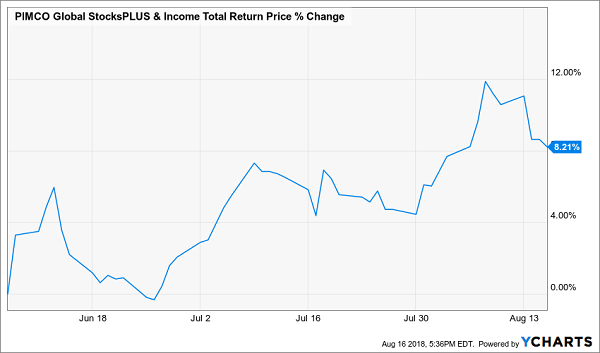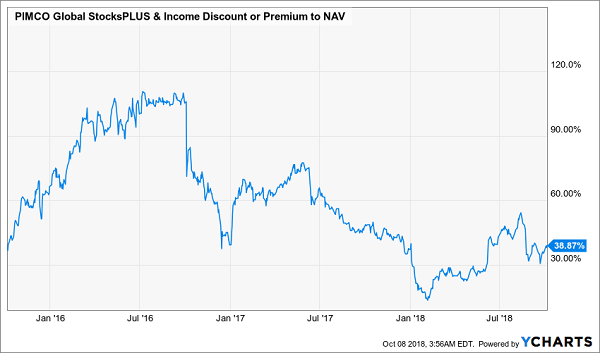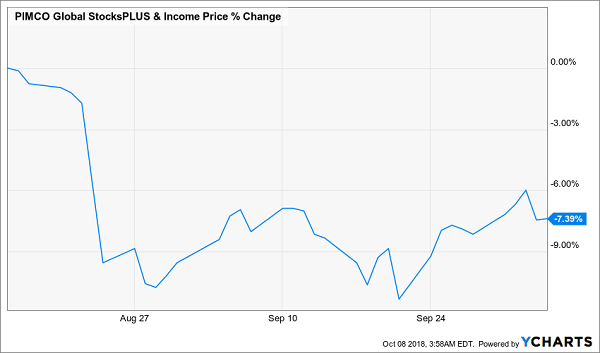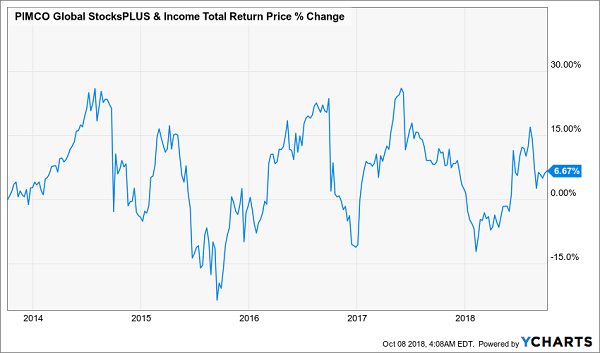Today I’m going to show you a quick trade you can repeat over and over for an 8% gain in just over 2 months (or 40% annualized!).
How do I know?
Because this is exactly what happened with the PIMCO Global StocksPlus & Income Fund (PGP), which I urged Contrarian Outlook readers to buy in June and then sell in August.
A Fast, Easy Gain

So how was this win so easy to call the last time around, and how can we ride PGP and other funds to the same—and even bigger—gains in the future?
Let’s start at the beginning.
Inside a 40% Annualized Gain
PGP is one of PIMCO’s most popular closed-end funds (CEFs), which is saying a lot, since the company is the most popular CEF manager out there. Where most CEFs trade at a discount to their net asset value (NAV, or the value of their underlying portfolios), PIMCO’s funds almost always trade at a premium.
And those premiums can get really high, like the totally absurd 100% markup PGP attracted in 2016:
PGP Sets a CEF Price Record

This ridiculous premium was a record for PGP: while this fund has historically traded at a high premium, it never went this high. And it’s never been that high since.
This, by the way, points to a mistake “first-level” CEF investors make all the time: they’ll latch onto a fund, bid it up to the breaking point, then hold on and take a big hit when the premium collapses.
That 8.2% return we got from June to August? It’s mostly disappeared since—if you didn’t sell when I urged you to, you’d be facing nearly 8% in capital losses:
A Quick Win Evaporates

But luckily we were tipped off to this loss ahead of time by the very same indicator we used to buy in the first place: the premium to NAV.
Over a long time period, individual CEFs tend to follow a predictable pattern unique to that particular fund. For PGP, it’s obvious. Look at the premium-to-NAV trend in the last 5 years:
A Predictable Pattern

There’s a clear oscillation from a very high premium to a lower one and back again.
Crucially, there’s a proportional relationship between the percentage loss in the premium from peak to trough that determines how high the premium will go when it bounces higher the next time.
In the case of PGP, you just have to add in one more element you can’t see on the chart above to make this crystal clear: average returns in the junk-bond market, to which the fund’s portfolio is most closely linked.
For instance, in late 2015, the fund saw a relatively moderate decline in its 80%-ish premium to NAV, to around 30%, when the junk-bond market was in a free-fall because of the Federal Reserve’s first interest-rate hike. Investors (incorrectly) saw this as resilience in demand for PGP in 2016, causing the premium to soar to its absurd 100%+ level.
Conversely, when that massive premium collapsed in early 2017, even when junk bonds were doing well, the new premium PGP could command by mid-2017 was its lowest peak premium in 5 years.
When to Move on PGP Again
So is now the time to buy?
The answer is no, but it may be soon.
Since PGP’s peak premium to NAV was so low last time, despite a low but still positive return for junk bonds, the market isn’t showing enough confidence in PGP to ensure that the trough of this pricing cycle is higher than the last one. And that means we need to wait until PGP’s premium to NAV widens to around 25% before considering a move into it.
If we continue to track PGP, we can find more opportunities to buy when its premium has reached its lowest point, then hold for a few months and cash out with a 40% annualized return in a matter of weeks.
Identifying this pattern, both here and in other CEFs (something I do for you in my CEF Insider service), is key to locking in both fast upside and a secure 7%+ income stream from these funds over the long haul.
Finally, to show you just how important timing is with a fund like PGP, if you’d bought it 5 years ago, you’d have a measly 6.7% total return for the whole 5-year holding period.
A Dud of an Investment

Imagine getting a lower return over 5 years than we got in just over 2 months with the same fund!
In markets, as in life, timing is crucial.
Urgent: These 4 Funds Are Ready to Skyrocket 27% (don’t miss out)
While now isn’t (yet) the time to make our next pivot into PGP, don’t worry. I’ve got 4 more CEFs trading at huge discounts to NAV waiting for you here.
These discounts are so big that that these 4 funds are “locked in” for fast “snapback” price gains of 20% and more as their bizarre markdowns soar back to normal levels—which they simply must do (it’s the “law of gravity” for these off-the-radar funds).
That means there’s zero legwork for you to do on these 4 funds. I’ve done it all for you!
And I’ve come to one unavoidable conclusion: BUY NOW.
Because here’s something else you should know about these 4 funds’ ludicrous markdowns: they give us crucial downside protection, because even if the market takes a header tomorrow, these 4 CEFs are already heavily discounted, so they’ll simply trade flat!
And we’ll still collect their massive dividends (which I’ll tell you about now).
Huge Cash Dividends Bump Your Gain to 27%
As I write, these 4 funds pay an impressive—and SAFE—7.1% dividend yield, on average, with the highest of the bunch hitting 8%.
Even better, all 4 of these cash machines (which, by the way, we’ll be holding for years, not months) pay dividends monthly, so your cash stream will line up with your monthly bills. Or you can reinvest your dividends faster, goosing your gains—and income stream—as you do!
Add it all up and you’re looking at a 27%+ total return in the next 12 months here, with a nice chunk of those gains headed your way in safe CASH.
These 4 CEFs are “must haves” for any retirement portfolio, and they’re only a click away! Simply click here and I’ll reveal all 4 of them, including their names, ticker symbols, buy-under prices and everything you need to know before you buy!

Recent Comments